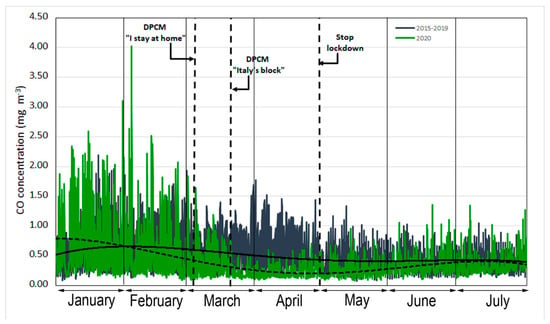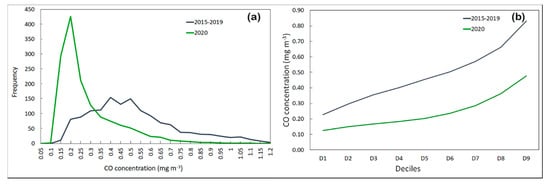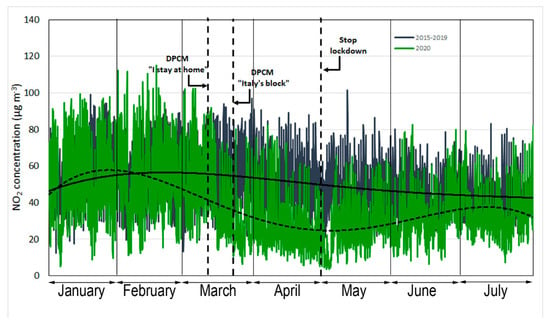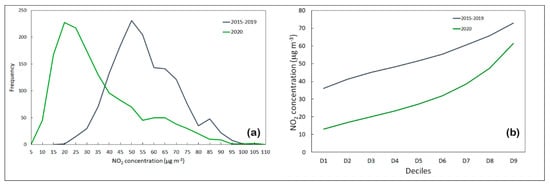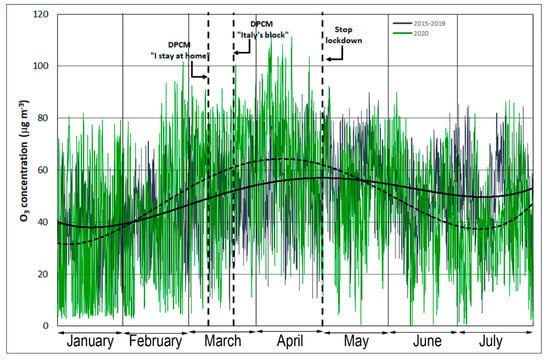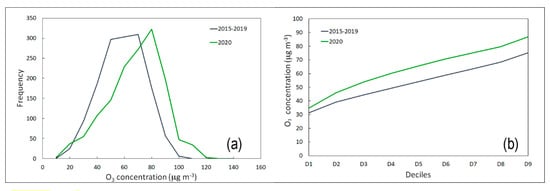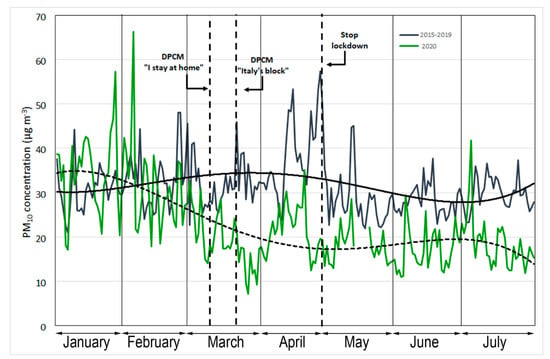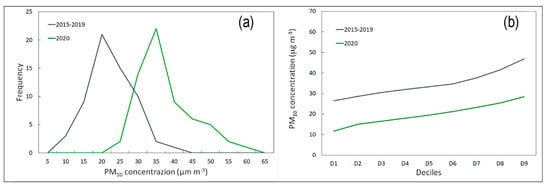Abstract
At the end of 2019, the first cases of coronavirus disease (COVID-19) were reported in Wuhan, China. Thereafter, the number of infected people increased rapidly, and the outbreak turned into a national crisis, with infected individuals all over the country. The COVID-19 global pandemic produced extreme changes in human behavior that affected air quality. Human mobility and production activities decreased significantly, and many regions recorded significant reductions in air pollution. The goal of our investigation was to evaluate the impact of the COVID-19 lockdown on the concentrations of the main air pollutants in the urban area of Palermo (Italy). In this study, the trends in the average concentrations of CO, NO2, O3, and PM10 in the air from 1 January 2020 to 31 July 2020 were compared with the corresponding average values detected at the same monitoring stations in Palermo during the previous five years (2015–2019). During the lockdown period (10 March–30 April), we observed a decrease in the concentrations of CO, NO2, and particulate matter (PM)10, calculated to be about 51%, 50%, and 45%, respectively. This confirms that air pollution in an urban area is predominantly linked to vehicular traffic.
1. Introduction
The new severe acute respiratory syndrome-coronavirus (SARS-CoV2) has had an unprecedented impact around the world. The spread of the 2019 coronavirus disease (COVID-19), initially identified in Wuhan in China, led to over one million cases worldwide in the first four months [1]. The virus has affected almost all countries on the planet (235 in total), causing so far over 34 million confirmed cases and about 1,030,000 deaths [2]. This has resulted in lockdown in many nations. The COVID-19 pandemic has substantially affected the human society, including healthcare, economic structures, and social relationships [3].
In Italy, between the months of February and March, a series of national and regional legislative measures were issued to stop the spread of COVID-19, which radically changed the daily habits and lifestyles of citizens. The lockdown and the related implemented measures led to a sudden drop in economic activities, including a fall in road transport in many cities and a drastic reduction in the movement of citizens through the adoption of smart-working practices wherever possible.
In Italy, the Decree of the President of the Council of Ministers (DPCM) of 9 March 2020 [4], also known as the “I stay at home” Decree, extended the measures on confinement and restriction on travel to the whole country and prohibited any form of gathering of people in public places or locations open to the public, also suspending sporting and cultural events. The DPCM of 21 March 2020 [5], known as “Italy’s block”, blocked non-essential activities and imposed a ban on moving to different municipalities. In Italy, lockdown and travel restrictions were maintained until 3 May 2020.
Is lockdown a factor influencing air pollution?
Reducing air pollution could be considered part of an integrated approach for the protection of human health and the prevention of epidemic spread. The role of air pollution in contributing to the high levels of SARS-CoV-2 lethality in northern Italy has been hypothesized [6,7].
Exposure to air pollution is an important and persistent risk factor for death by different causes and for a high incidence of respiratory diseases [8,9]. Deaths associated with air pollution include aggravated asthma, bronchitis, emphysema, lung and heart disease, and respiratory allergies [8]. Among the atmospheric pollutants, the focus is mainly on nitrogen dioxide (NO2), particulate matter (PM2.5 and PM10), and ozone (O3), which are frequently found at high concentrations in urban areas.
Various studies have reported a direct relationship between the spreading and contagion capacity of some viruses and the atmospheric levels and mobility of atmospheric pollutants [10,11]. The results provided by Zhu et al. [12] indicated that a significant relationship exists between air pollution and COVID-19 infection, which could partially explain the effect of the national block and provide implications for the control and prevention of this new disease.
A decline in anthropogenic air pollution has been observed in countries that have responded to the COVID-19 pandemic with a total closure of all activities. Satellite data recorded by the NASA Earth Observatory showed that NO2 concentrations in eastern and central China from the beginning of 2020 were 10–30% lower than those in comparable periods in 2019 [13]. In particular, in Hubei province (China), strict social distancing measures that affected the main economic activities of the region were implemented from December 2019; power plants and industrial structures stopped production, and the use of vehicles decreased considerably [14]. This led to a drastic reduction in the levels of NO2 and fine atmospheric particulate matter [15,16]. The European Environment Agency found a similar decrease in air pollution in European cities [17]. Air pollution drastically reduced as major industries and other regular businesses came to a halt, leading to a sharp reduction in NO2 concentrations in countries such as France, Germany, Italy, and Spain [14,18,19]. From 16 to 22 March 2020, Bergamo (Italy) and Barcelona (Spain) showed decreases in NO2 of 47% and 55% compared to the same dates in 2019, respectively. The impact of the COVID-19 pandemic on air pollution measured by the United States using the federal air monitoring network showed strong reductions in fine particulate matter (PM2.5) and NO2, corresponding to reduced traffic and mandatory company closures [20].
In our investigation, we explored the impact of COVID-19-relatd restrictions on the main air pollutant concentrations, CO, NO2, O3, and PM10, measured in the city of Palermo (Italy) using the municipal air-monitoring network. We used statistical and quantitative analyses of the relationships between air pollution, human mobility, and travel restrictions to infer the effects on air quality.
The objectives of this study were: (1) to compare the concentrations of the main atmospheric pollutants determined in the city of Palermo (Italy) during the pre-lockdown, lockdown, and post-lockdown periods; (2) compare the collected data with those of the same time window in the previous five years (2015–2019); and (3) evaluate the usefulness of the block as an alternative strategy for reducing the level of atmospheric pollution in the city of Palermo.
2. Materials and Methods
Description of the Area and Sampling Sites
With about 680,000 inhabitants, Palermo is the largest urban area of Sicily, and its metropolitan area is populated by more than one million people. The city is situated on the north-western coast of the island, facing the Tyrrhenian Sea on the northeast and surrounded by mountains (Monti di Palermo) reaching 500–1000 m above sea level. The climate is typically Mediterranean, with warm dry summers and moderately rainy winters. The prevailing wind directions are from the east and west. The city of Palermo is periodically affected by frequent warm winds coming from the south-east (Sirocco winds) and the southwest (Libeccio winds), carrying dust raised from the Sahara Desert region throughout the Mediterranean basin, which considerably influences the concentration of PM10. Potential local pollutants are limited to emissions from traffic, domestic heating, and small manufacturing industries.
We decided to compare the data collected from monitoring stations during the period from 1 January 2020 to 31 July 2020 with the averages for the same period calculated for the five-year period of 2015–2019.
The CO, NO2, and O3 values were recorded hourly, whereas the PM10 values were recorded daily. Each hourly or daily value for the five-year period is the result of the average calculated from all the values recorded in the same hour or day in the considered five years. From the data of the five-year period, the values due to abnormal and/or exceptional weather conditions and not attributable to anthropogenic emissions were deleted.
The comparison was performed using data on pollutants collected from monitoring stations, shown in Table 1. In total, 213 days were analyzed for CO, NO2, O3, and PM10 in urban stations. The selected urban stations are close to roads with different densities of vehicles, urban buses, and extra-urban buses.
Gas analyses were performed using the municipal air quality monitoring network managed by Risorse Ambiente Palermo (RAP). Ambient CO concentration measurements were recorded according to European standard EN 14626; NO2 concentration was analyzed according to European standard EN 14211 [21]. Ambient O3 concentration measurements were recorded according to European standard EN 14625 via ultraviolet photometry. PM10 was sampled with a beta gauge analyzer (Environnement S.A. MP101M, ENVEA, Italy), certified as equivalent to the reference method in accordance with EN12341 [22] (stations: Di Blasi and Giulio Cesare) and another beta gauge analyzer (OPSIS SM200, OPSIS, Sweden) for the Castelnuovo and Indipendenza stations.
3. Results and Discussion
3.1. Gaseous Air Pollutants, CO, NO2, and O3
The average concentrations of the gaseous air pollutants carbon monoxide (CO) and nitrogen dioxide (NO2) were used to verify the impact on pollution of the closure of all activities in a city.
The main sources of CO emissions are linked to incomplete combustion processes of natural gas, diesel, or gasoline from engines and household heating [23]. In recent years, the levels of CO in Palermo city were below the limit of 10 mg m−3 (maximum daily eight-hour mean) fixed by Directive 2008/50/EC [24]. Figure 1 shows the temporal trend in the hourly average concentration of carbon monoxide in the atmosphere, detected for the period from 1 January 2020 to 31 July 2020 for the urban stations compared to the trend of the hourly average concentration resulting from the processing of the data of the five-year period of 2015–2019 for the same months.
Figure 1.
Time series of hourly CO (mg m−3) concentrations measured from 1 January to 31 July. The dotted and solid regression lines indicate the 2020 and 2015–2019 trends, respectively.
The trend for the hourly concentrations in the city of Palermo showed a drop in the week preceding the Prime Minister’s decree of 9 March 2020. Following the detection of COVID-19 cases since 20 February, the closure of all schools and grades had already been implemented.
From 10 March (DPCM 9 March 2020 [4], “I stay at home”) and even more evident from 22 March (DPCM 21 March 2020 [5] “Italy’s block”), which defined the total lockdown, CO concentrations were lower than the corresponding values of the five-year (2015–2019) period, confirming that the main source of CO was heavy vehicular traffic. After the end of the lockdown, we observed that CO concentrations tended to slowly increase until they reached very similar values to those of the month of July of the 2015−2019 period.
In Figure 2a, we report the frequency distribution of two temporal trends, where the sharp reduction observed during the lockdown period is more evident. Figure 2b plots the deciles calculated for the two trends, showing that D5 was 0.2 mg m−3 for the 2020 distribution and 0.47 mg m−3 for the 2015−2019 distribution, representing a reduction of −56%.
Figure 2.
(a) Frequency distribution and (b) deciles of two temporal trends, from 1 March to 30 April, of CO concentrations (mg m−3).
A similar trend was observed for nitrogen dioxide (Figure 3). The average NO2 concentrations at the urban stations did not exceed the legal limit of 200 µg·m−3 (in one hour) but exceeded the annual mean of 40 µg·m−3, imposed by Directive 2008/50/EC [24] in the 2015–2019 period.
Figure 3.
Time series of hourly NO2 (µg·m−3) concentrations measured from 1 January to 31 July. The dotted and solid regression lines indicate the 2020 and 2015-2019 trends, respectively.
From 1 January to 10 March 2020, the trend in the hourly concentration of NO2 can be superimposed on that observed in the prior five-years. Since the DPCM of 9 March 2020, a drastic decrease in the hourly concentration of NO2 was observed. Nitrogen dioxide in the atmosphere is a highly reactive pollutant emitted from burning fossil fuels (diesel, gasoline, and coal) [25,26]. This pollutant is considered a good indicator of air pollution in urban areas, as its concentration is heavily influenced by transport and mobility of citizens. At the end of the lockdown, some economic activities did not resume, schools and universities remained closed, and smart working was maintained. This reopening period coincided with the partial emptying of the city for the summer holidays. The density of motor vehicles decreased because of the use of bicycles and scooters.
Figure 4 shows the frequency distribution and deciles of two temporal trends. The trend in NO2 concentration observed is similar for the two periods, but with a strong concentration reduction in 2020. The concentrations decreased significantly during the lockdown due to the stoppage of transport and low mobility [27,28].
Figure 4.
(a) Frequency distribution and (b) deciles of two temporal trends of NO2 concentrations (µg·m−3) from 1 March to 30 April.
Table 2 reports the average values for CO and NO2 pollutants at the individual monitoring stations. The measured values showed that the link between improved air quality and traffic density was more visible in the DB and GC monitoring stations, with variations during the lockdown between −58% and −43% for CO and −37% and −54 % for NO2.
The statistical descriptions for CO and NO2 considering the period 1 March–30 April, the period after the first DPCM (10 March–30 April), and that after the second DPCM (22 March−30 April) are provided in Table 3. The calculated percentage changes show a strong decrease in carbon monoxide and nitrogen dioxide between the periods considered. The two-tailed paired t-test showed that the observed differences among the three groups were statistically significant at p < 0.05.
Ozone levels have increased as a result of human activities. Photochemical processes influenced by anthropogenic emissions of ozone precursors (NO2 and volatile organic compounds (VOCs)) have caused the current tropospheric ozone levels to be substantially higher compared to the natural background levels [29]. The critical aspect of ozone is related to its complex photochemistry, as the rates of ozone formation and accumulation are non-linear functions of the mixture of VOCs and NOx in the atmosphere [30]. Under certain conditions, NOx reduction can lead to higher ambient ozone levels [31]. Motor vehicles are the main source of NOx emissions in an urban area; the increase in ozone production has been linked to the reduction in vehicular traffic [32,33]. The increase in ozone concentration that occurred during the lockdown is highlighted in Figure 5 and Figure 6.
Figure 5.
Time series of hourly O3 (µg·m−3) concentrations measured from 1 January to 31 July at the CS monitoring station. The dotted and solid regression lines indicate the 2020 and 2015-2019 trends, respectively.
Figure 6.
(a) Frequency distribution and (b) deciles of two temporal trends from 1 March to 30 April of O3 concentrations (µg·m−3) from 1 March to 30 April.
The temporal analysis of the O3 level showed an opposite behavior during the block (63 µg·m−3) compared to the average values of NO2 (21 µg·m−3) at the same monitoring station. An increase in O3 is usual during spring and summer due to the higher solar radiation (in terms of intensity and daily duration), which promotes the photolysis of NO2 [34,35]. The increase in ozone concentrations registered in Palermo during the lockdown is linked to two factors: the decrease in NO2 and the increased solar radiation [36].
3.2. Particulate Matter PM10
Particulate matter in urban areas is mainly composed of mineral dust, metals, metalloids, sea salts, ammonium nitrate and sulfate, organic compounds, and elemental carbon [37]. Anthropogenic airborne particulate matter comes from a variety of sources, including traffic, industry, commerce, and domestic heating [23].
The daily variation in PM10 from 1 January to 31 July for the average values of 2015–2019 and for 2020 is shown in Figure 7. The mean concentration of particulate matter from 1 March to 30 April was higher during 2015–2019 (35 µg·m−3) than in 2020 (20 µg·m−3), representing a change of −43%. The effect of movement restrictions imposed by the authorities from 9 March and subsequently from 21 March marked a further overall decrease in PM10 of 45–48% compared to the same period in 2015–2019. The average values measured from 9 March to 30 April were 36 µg·m−3 (2015–2019) and 20 µg·m−3 (2020); from 21 March to 30 April, the mean measured concentrations were 37 µg·m−3 (2015–2019) and 19 µg·m−3 (2020). For the period following the end of the lockdown (1 May to 31 July), the average measured values were 29 µg·m−3 (2015–2019) and 18 µg·m−3 (2020), which is a change of −60%. Figure 8 shows the significant difference between the two frequency distributions. In particular, the median values report concentrations of 35 µg·m−3 (2015−2019) and 19.4 µg·m−3 (2020).
Figure 7.
The daily values of ambient concentrations of PM10 (µg·m−3) measured from 1 January to 31 July. The dotted and solid regression lines indicate the 2020 and 2015-2019 trends, respectively.
Figure 8.
(a) Frequency distribution and (b) deciles of two temporal trends of PM10 concentrations (µg·m−3) from 1 March to 30 April.
The 24 h average daily values of ambient concentrations of PM10, measured at each of the four sampling sites during the study period, are reported in Table 4. The GC, IND, and DB sites showed higher percentage changes of −43%, −44%, and −53%, respectively, between 1 March and 30 April.
Table 4.
Average concentrations of PM10 at individual monitoring stations. Data are expressed in µg·m−3. Parametric t-test at p < 0.05. The italics indicates not-significant t-test.
These results can be attributed to the reduction in vehicular traffic as a consequence of the closure of all schools and universities and the decrease in workers’ movements. This hypothesis is confirmed by several previous studies conducted in the same area, in which the background value for PM10 was estimated to be around 23 µg·m−3 on the basis of a linear correlation between PM10 and CO and NO2 [38,39]. Thus, the constant presence of a fraction of PM10, not strictly related to vehicle emissions, could result from soil and road dust particle resuspension. Dongarra et al. [39] confirmed that about 50% of particulate matter is produced by road traffic.
The reported data highlight the changes in air quality during the lockdown period. Strict alternative measures could be envisaged, such as short-term blocks, for pollution reduction in urban air. Table 5 shows that the decreases in CO, NO2, and PM10 concentrations can be evaluated starting from the first six days of block. A statistical evaluation was conducted, which highlighted percentage changes of concentrations between 31% and 66% for CO, between 30% and 52% for NO2, and between 24% and 59% for PM10. The t-test confirmed that the variations observed CO, NO2, and PM10 between the lockdown period and the previous five years were statistically significant (2015–2019; p < 0.05).
3.3. Pre-Lockdown
To verify the findings of the analysis of this study and the reliability and representativeness of the 2015–2019 database, a statistical analysis was also conducted to check the percentage changes for each pollutant from 1 January to 29 February 2020. During this period, the city of Palermo was not affected by any restrictions related to the COVID-19 pandemic. The results obtained showed that in the period considered, the differences between the average and the median between the two data series were practically negligible, and the variations were all less than 6% in absolute value for the arithmetic means and 10% for the medians, as shown in Table 6. The data obtained confirmed, despite the many variables involved, the reliability and representativeness of the 2015–2019 database used for the comparison.
4. Conclusions
Air pollution studies should be considered as part of an integrated approach for sustainable development and the protection of human health. The national lockdown during the COVID-19 pandemic provided an opportunity to work on improving air quality. The results of this study demonstrate that anthropogenic activities strongly influence air quality. The lockdown period produced a sharp reduction in all pollutants that are closely linked to vehicular traffic. In the urban area of Palermo (Italy) from 10 March to 30 April, the concentrations of CO, NO2, and PM10 decreased to about 51%, 50%, and 45%, respectively. The period of forced block produced decreases in the concentrations of CO, NO2, and PM10 from the first six days of lockdown. The lack of a decrease of tropospheric ozone during the block due to non-linear chemical effects showed that these reductions will remain challenging, even with effective policies to reduce primary pollutants.
The findings reported here are a useful indication for competent authorities to rethink existing regulatory plans and provide assurance for the implementation of rigorous alternative measures such as short-term blocks to produce a real improvement in air quality.
Author Contributions
Conceptualization, M.V., D.V., and M.G.A.; Methodology, M.V.; Data curation, M.V.; Formal analysis, M.V., M.G.A., and D.V.; Writing—original draft, M.V., D.V., and M.G.A. All authors have read and agreed to the published version of the manuscript.
Funding
This research did not receive any specific grant from funding agencies in the public, commercial, or not-for-profit sectors.
Acknowledgments
We would like to thank the Risorse Ambiente Palermo (RAP) (http://www.rapspa.it/site/) for providing us with the PM10 data and the gaseous pollutants information. In particular, our sincere gratitude is due to Michela Cirrito and Nicoletta Marramaldo (RAP Laboratory staff) for data collection during the COVID-19 lockdown.
Conflicts of Interest
The authors declare no conflict of interest.
References
- Mahato, S.; Pal, S.; Ghosh, K.G. Effect of lockdown amid COVID-19 pandemic on air quality of the megacity Delhi, India. Sci. Total Environ. 2020, 730, 1–23. [Google Scholar] [CrossRef] [PubMed]
- WHO. 2020. Available online: https://www.who.int/emergencies/diseases/novel-coronavirus-2019 (accessed on 4 October 2020).
- Dutheil, F.; Baker, J.S.; Navel, V. COVID-19 as a factor influencing air pollution? Environ. Pollut. 2020, 263, 114466. [Google Scholar] [CrossRef] [PubMed]
- DPCM 9 Marzo 2020, n. DPCM 9 Marzo 2020, n. 14. Ulteriori disposizioni attuative del decreto-legge 23 febbraio 2020, n. 6, recante misure urgenti in materia di contenimento e gestione dell’emergenza epidemiologica da COVID-19, applicabili sull’intero territorio nazionale. (20A01558) (GU Serie Generale n.62 del 09-03-2020). Available online: https://www.gazzettaufficiale.it/eli/id/2020/03/09/20A01558/sg (accessed on 10 March 2020).
- DPCM 21 Marzo 2020. Ulteriori misure urgenti in materia di contenimento e gestione dell’emergenza epidemiologica da COVID-19, applicabili sull’intero territorio nazionale. (GU Serie Generale n.75 del 22-03-2020). Available online: https://www.gazzettaufficiale.it/eli/id/2020/03/22/20A01806/sg (accessed on 22 March 2020).
- Conticini, E.; Frediani, B.; Caro, D. Can atmospheric pollution be considered a co-factor in extremely high level of SARS-CoV-2 lethality in Northern Italy? Environ. Pollut. 2020, 114465. [Google Scholar] [CrossRef] [PubMed]
- Fattorini, D.; Regoli, F. Role of the chronic air pollution levels in the Covid-19 outbreak risk in Italy. Environ. Pollut. 2020, 264, 114732. [Google Scholar] [CrossRef] [PubMed]
- Brauer, M. How much, how long, what, and where: Air pollution exposure assessment for epidemiologic studies of respiratory disease. Proc. Am. Thorac. Soc. 2010, 7, 111–115. [Google Scholar] [CrossRef]
- Burnett, R.; Chen, H.; Szyszkowicz, M.; Fann, N.; Hubbell, B.; Pope, C.A.; Apte, J.S.; Brauer, M.; Cohen, A.; Weichenthal, S.; et al. Global estimates of mortality associated with long-term exposure to outdoor fine particulate matter. Proc. Natl. Acad. Sci. USA 2018, 115, 9592–9597. [Google Scholar] [CrossRef]
- Ciencewicki, J.; Jaspers, I. Air pollution and respiratory viral infection. Inhal. Toxicol. 2007, 19, 1135–1146. [Google Scholar] [CrossRef]
- Sedlmaier, N.; Hoppenheidt, K.; Krist, H.; Lehmann, S.; Lang, H.; Büttner, M. Generation of avian influenza virus (AIV) contaminated fecal fine particulate matter (PM2.5): Genome and infectivity detection and calculation of immission. Vet. Microbiol. 2009, 139, 156–164. [Google Scholar] [CrossRef]
- Zhu, Y.; Xie, J.; Huang, F.; Cao, L. Association between short-term exposure to air pollution and COVID-19 infection: Evidence from China. Sci. Total Environ. 2020, 727. [Google Scholar] [CrossRef]
- Patel, K. 2020 Airborne Nitrogen Dioxide Plummets over China. Available online: https://www.earthobservatory.nasa.gov/images/146362/airborne-nitrogen-dioxide-plummets-over-china (accessed on 4 October 2020).
- Zambrano-Monserrate, M.A.; Alejandra Ruano, M.; Sanchez-Alcalde, L. Indirect effects of COVID-19 on the environment. Sci. Total Environ. 2020, 728, 138813. [Google Scholar] [CrossRef]
- ESA. 2020. Available online: https://www.esa.int/Applications/Observing_the_Earth/Copernicus/Sentinel-5P/COVID-19_nitrogen_dioxide_over_China (accessed on 4 April 2020).
- CAMS. 2020. Available online: https://atmosphere.copernicus.eu/amid-coronavirus-outbreak-copernicus-monitors-reduction-particulate-matter-pm25-over-china (accessed on 4 April 2020).
- European Environmental Agency. Air Pollution Goes down as Europe Takes Hard Measures to Combat Coronavirus. European Environment Agency. 2020. Available online: https://www.eea.europa.eu/highlights/air-pollution-goes-down-as (accessed on 4 October 2020).
- ESA. 2020. Available online: https://www.esa.int/Applications/Observing_the_Earth/Copernicus/Sentinel-5P/Coronavirus_lockdown_leading_to_drop_in_pollution_across_Europe (accessed on 4 October 2020).
- Sharma, P.; Dhar, A. Effect of hydrogen supplementation on engine performance and emissions. Int. J. Hydrog. Energy 2018, 43, 7570–7580. [Google Scholar] [CrossRef]
- Berman, J.D.; Ebisu, K. Changes in U.S. air pollution during the COVID-19 pandemic. Sci. Total Environ. 2020, 739. [Google Scholar] [CrossRef] [PubMed]
- CEN. Ambient Air Quality. Standard Method for the Measurement of the Concentration of Nitrogen Dioxide and Nitrogen Monoxide by Chem-Iluminescence, EN 14211 41. 2005. Available online: https://standards.iteh.ai/catalog/standards/cen/181f3d8d-a64c-46fb-b90a-7affd10c7c0b/en-14211-2005 (accessed on 11 June 2008).
- CEN. Air Quality-Determination of the PM10 Fraction of Suspended Particulate Matter-Reference Method and Field Test Procedure to Demonstrate Reference Equivalence of Measurement Methods, EN123. 1998. Available online: https://ec.europa.eu/environment/air/pdf/finalwgreporten (accessed on 18 November 1998).
- Han, X.; Luke, P.N. A review of traffic-related air pollution exposure assessment studies in the developing world. Environ. Int. 2006, 32, 106–120. [Google Scholar] [CrossRef]
- EU-Commission. Directive 2008/50/EC of the European Parliament and of the Council of 21 May 2008 on Ambient Air Quality and Cleaner Air for Europe. 2008. Available online: https://eur-lex.europa.eu/legal-content/en/TXT/?uri=CELEX%3A32008L0050 (accessed on 11 June 2008).
- He, L.; Zhang, S.; Hu, J.; Li, Z.; Zheng, X.; Cao, Y.; Xu, G.; Yan, M.; Wu, Y. On-road emission measurements of reactive nitrogen compounds from heavy-duty diesel trucks in China. Environ. Pollut. 2020, 114280. [Google Scholar] [CrossRef] [PubMed]
- He, M.Z.; Kinney, P.L.; Li, T.; Chen, C.; Sun, Q.; Ban, J.; Wang, J.; Liu, S.; Goldsmith, J.; Kioumourtzoglou, M.A. Short- and intermediate-term exposure to NO2 and mortality: A multi-county analysis in China. Environ. Pollut. 2020, 114165. [Google Scholar] [CrossRef] [PubMed]
- ESA. 2020. Available online: https://www.esa.int/Applications/Observing_the_Earth/Co-pernicus/Sentinel-5P (accessed on 27 March 2020).
- Muhammad, S.; Long, X.; Muhammad, S. COVID-19 pandemic and environmental pollution: A blessing in disguise? Sci. Total Environ. 2020, 728, 138813. [Google Scholar] [CrossRef]
- Zoran, M.A.; Savastru, R.S.; Savastru, D.M.; Tautan, M.N. Assessing the relationship between ground levels of ozone (O3) and nitrogen dioxide (NO2) with coronavirus (COVID-19) in Milan, Italy. Sci. Total Environ. 2020, 740, 14005. [Google Scholar] [CrossRef] [PubMed]
- Stockwell, W.R.; Lawson, C.V.; Saunders, E.; Goliff, W.S. A review of tropospheric atmospheric chemistry and gas-phase chemical mechanisms for air quality modeling. Atmosphere 2012, 3, 1–32. [Google Scholar] [CrossRef]
- Finlayson-Pitts, B.J.; Pitts, J.N. Chemistry of Upper and Lower Atmosphere; Academic Press: San Diego, CA, USA, 2000. [Google Scholar]
- Fujita, E.M.; Campbell, D.E.; Stockwell, W.R.; Lawson, D.R. Past and future ozone trends in California’s South Coast Air Basin: Reconciliation of ambient measurements with past and projected emission inventories. J. Air Waste Manag. Assoc. 2013, 63, 54–69. [Google Scholar] [CrossRef]
- Fujita, E.M.; Stockwell, W.R.; Campbell, D.E.; Keislar, R.E.; Lawson, D.R. Evolution of the magnitude and spatial extent of the weekend ozone effect in California’s South Coast Air Basin, 1981–2000. J. Air Waste Manag. Assoc. 2003, 53, 802–815. [Google Scholar] [CrossRef]
- Escudero, M.; Segers, A.; Kranenburg, R.; Querol, X.; Alastuey, A.; Borge, R.; de la Paz, D.; Gangoiti, G.; Schaap, M. Analysis of summer O3 in the Madrid air basin with the LOTOS-EUROS chemical transport model. Atmos. Chem. Phys. 2019, 19, 14211–14232. [Google Scholar] [CrossRef]
- Wang, P.; Qiao, X.; Zhang, H. Modeling PM2.5 and O3 with aerosol feedbacks using WRF/Chem over the Sichuan Basin, southwestern China. Chemosphere 2020, 254, 126735. [Google Scholar] [CrossRef]
- Sharma, S.; Zhang, M.; Anshika, G.J.; Zhang, H.; Kota, S.H. Effect of restricted emissions during COVID-19 on air quality in India. Sci. Total Environ. 2020, 138, 138878. [Google Scholar] [CrossRef] [PubMed]
- Varrica, D.; Tamburo, E.; Vultaggio, M.; Di Carlo, I. ATR–FTIR Spectral Analysis and Soluble Components of PM10 And PM2.5 Particulate Matter over the Urban Area of Palermo (Italy) during Normal Days and Saharan Events. Int. J. Environ. Res. Public Health 2019, 16, 2507. [Google Scholar] [CrossRef] [PubMed]
- Dongarrà, G.; Manno, E.; Varrica, D. Possible markers of traffic-related emissions. Environ. Monit. Assess. 2009, 154, 17–125. [Google Scholar] [CrossRef]
- Dongarrà, G.; Manno, E.; Varrica, D.; Lombardo, M.; Vultaggio, M. Study on ambient concentrations of PM10, PM10–2.5, PM2.5 and gaseous pollutants. Trace elements and chemical speciation of atmospheric particulates. Atmos. Environ. 2010, 44, 5244–5257. [Google Scholar] [CrossRef]
© 2020 by the authors. Licensee MDPI, Basel, Switzerland. This article is an open access article distributed under the terms and conditions of the Creative Commons Attribution (CC BY) license (http://creativecommons.org/licenses/by/4.0/).

